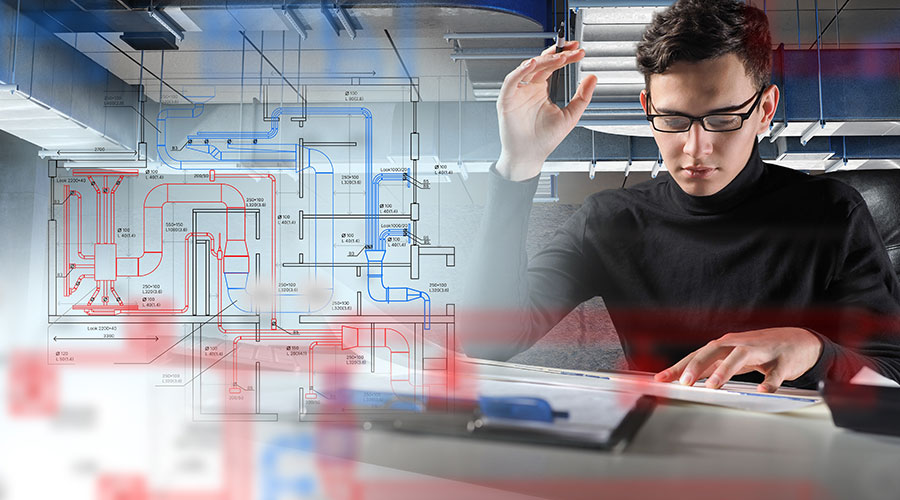Infrared Imaging: An Inside Look
Advances in infrared diagnostic technology let technicians detect minor, hidden problems before they become big headaches
Institutional and commercial facilities increasingly feature advanced systems and technology in almost all areas, and more complex systems are on the way. These advances mandate that engineering and maintenance managers tap into new technology to ensure these systems perform efficiently over the long term.
Advances in infrared technology have created a new generation of tools and equipment that can help engineering and maintenance departments troubleshoot problems more quickly and efficiently.
The Latest Generation
New infrared imaging technology offers solutions to many older design limitations; namely, high cost, low precision, wavelength limitations, coverage, reliability, and limited portability. As their cost has declined, their features, ranges, reliability and portability have increased. New units are about the size of a video camera.
Conventional infrared imaging uses an optical method of non-contact, two-dimension measurement of the steady infrared energy — frequency outside the visual spectrum — emitted by an object. Now research and development of high-density imaging sensors has produced transient thermography.
This is different from conventional imaging in its use of externally applied, timed heating or cooling of the object. During heating or cooling, temperature changes pass through a homogeneous object in uniform waves. A defect, such as oxidation, causes a non-uniform progression, due to the higher thermal impedance of the defect, like a heating tube with buildup that slows the passage of heat. Right after the heat application, this temperature difference shows up on the thermal imager and reveals a defect’s hidden location.
Electrical-system Inspection
In many facilities, infrared inspections of electrical distribution systems are the most common applications for infrared imaging. This process can cover all areas from the service entrance to the smallest motor. The electrical service entrance, for example, includes the connection from the utility to the user’s power distribution system.
Typically there are pole insulators, high voltage switches, ground systems, transformers, circuit breakers, switch boxes, and terminals connecting the equipment to the wiring. All these connections — as well as many internal parts, such as windings in step-down transformers and motors — are supposed to operate within certain normal temperature rises above ambient. In typical transformers the bottom should be hotter than the top.
If infrared imaging detects higher-than-normal temperatures or an abnormal increase in the temperature during operation, the technician can schedule the equipment for further inspection. In some electrical equipment, cleaning or minor contact replacement might be all that is required at early stages. The repair is inexpensive and quickly done, and results in no unscheduled loss of service or major damage to equipment.
Beyond the service entrance, electrical distribution systems contain many more opportunities for infrared imaging application. Heaters, fuses, circuit breakers, switches, pushbuttons and wiring all have mechanical contacts between the wiring and controls. Any mechanical contact or terminal, as well as the wiring itself, can overheat due to age, loosening from vibration or temperature variation, deterioration or moisture-causing oxidation.
These processes are gradual. Before failure, heat buildup often occurs, and technicians can use imaging to measure, record and plot trends in heat buildup over time. Fires in cable trays or other overhead wiring occur all too often because it is time-consuming and difficult to access these locations for inspection. But left unattended, connections loosen, and heat builds up enough to cause serious damage to both the wiring and the building. The major advantage is that technicians don’t have to climb up there to check the equipment. They can be 20 feet away and do the inspection while the equipment is in service.
Anytime undetected heat problems exist, so does the danger of fire. Electrical system substations, switchgears, and motor-control-center components have been known to melt, burn or blow up due to overloads. Such conditions are dangerous to the safety and health of all the occupants. The equipment, sometimes located on mezzanines above the operating floor, can get so hot aluminum or copper conductors and even steel melt and shower nearby occupants with molten metal, spreading fire rapidly.
Additional Applications
Three other maintenance areas offer particularly high potential return on investment in infrared imaging equipment:
Mechanical-system measurement. Maintenance technicians can use imaging to measure heat variations in different areas of mechanical systems during operation. Infrared imaging can measure the variation in temperature from one place inside a closed unit to another. Hot spots found during operation reveal the locations of abnormal conditions in such equipment as bearings, shafts, fans, motors and gearboxes.
Building-envelope moisture detection. Technicians can check the efficiency of insulation on roof areas and identify moisture — which is a source of heat loss, rotting and mold if left undetected — presence or insulation failure, or heat loss in various places, including cracks or openings in the building envelope.
HVAC and boiler equipment checks. Imaging can zero in on destructive hot spots in boiler settings. Uneven distribution of heat can cause setting walls or tubes to fail prematurely. Early detection lets technicians correct hot-spot problems, such as fuel segregation or tube blockage. One such early detection can save many times the cost of the instrument and time to make the measurements.
Structural tests. Newer transient imaging can expose incipient structural problems early. These problems include: surface spalling, cracking and scaling; beam, truss and column defects; foundation and bearing system defects such as loose bolts and frozen bearing plates; and coating breakdown that can cause corrosion and delamination.
Selecting a Product
After deciding on benefits to achieve, the next step is to select from the vast array of products available, based on specific features the department needs. Among the considerations:
- Physical description. Consider the unit’s size and weight. Does the unit come with a tripod and case?
- Battery. What type of battery powers the unit? What is its charge life? Does the battery charger have one bay or two? Does it offer an AC adapter, a 12-volt car charger, and sleep mode?
- Ambient conditions. What kind of operating and storage temperature range does it operate in? What are its requirements for humidity, water and dust exposure? What are its limits for shock and vibration exposure?
- Image. Are images displayed on-camera in color LCD for instant analysis? What is its image capacity? Other features to consider include video output, image controls, palettes, auto-adjust level, span, minimum focus distance, thermal sensitivity, detector type, focal plane array (FPA), spectral range, setup controls, date/time, temperature units, language, scale, information fields, LCD intensity; adjustments, and emissivity correction.
The instrument’s thermal sensitivity enables it to detect subtle variations in temperature that might indicate larger problems. A maintenance-free, state-of-the-art FPA infrared detector produces high-sensitivity thermal images.
- PC connections. Is there software to download thermal images with measurements to a PC using standard USB or serial cable?
If technicians know the condition of equipment and the normal heat signature of heat-producing systems, they can compare those indices to the current readings periodically. In doing so, they are in a good position to detect and correct smaller problems before they send costs skyrocketing or cause a threat to occupants’ safety and health and to facility operations.
Infrared imaging can have a direct benefit to an organization’s bottom line. The longer facilities and equipment are in service before they must be replaced, the lower their life-cycle costs. The cost is spread over a longer period of time, so the return on the investment increases.
As buildings and equipment use more advanced technology, return on investment will become a greater concern to upper management, who are likely to pay much more attention to both preventive and predictive maintenance.
Related Topics:











